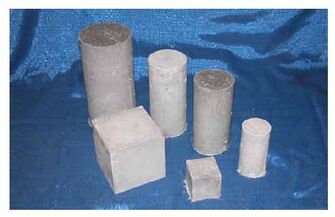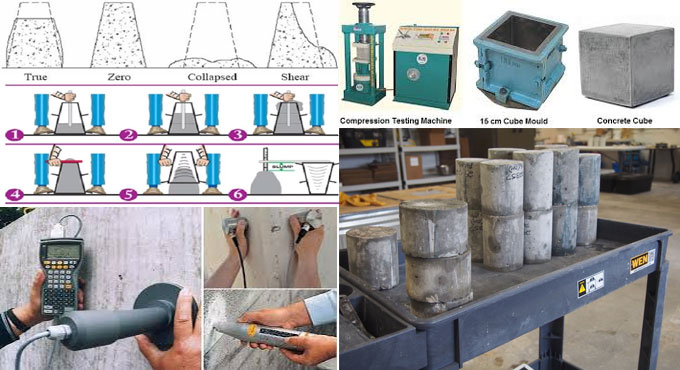Navigate Tasks with Confidence: Specialist Concrete Testing Near Me Unveiled
Navigate Tasks with Confidence: Specialist Concrete Testing Near Me Unveiled
Blog Article
Unraveling the Mysteries of Concrete Screening
Concrete screening is an essential facet of building and construction that is often forgotten or misconstrued. The toughness and toughness of concrete can make or damage a job, yet the mysteries surrounding the screening techniques can be bewildering. Exactly how do engineers properly determine the stamina of concrete? What factors can influence its efficiency? In this discussion, we will certainly untangle these secrets and shed light on the importance of concrete screening. By comprehending the various screening techniques and elements influencing concrete stamina, we can guarantee the top quality and durability of our structures. Allow us get started on this trip of exploration and demystify the world of concrete testing.
Significance of Concrete Testing
Concrete testing plays a critical role in guaranteeing the high quality and longevity of concrete frameworks. It is a crucial step in the building procedure that helps determine possible issues and guarantees the architectural honesty of buildings, bridges, roads, and various other concrete-based framework. By subjecting concrete samples to a series of extensive examinations, designers and contractors can obtain valuable insights into the material's stamina, make-up, and total performance.
One of the primary reasons that concrete testing is crucial is because it helps verify that the concrete mix used satisfies the needed requirements and criteria. By carrying out tests such as compressive toughness tests, slump examinations, and air material tests, experts can establish whether the concrete has the essential stamina and workability to withstand the intended lots and ecological problems.
Additionally, concrete testing allows for early discovery of any type of problems or deficiencies in the concrete mix. This very early recognition can assist avoid potential failings, such as fractures, spalling, or structural instability. By dealing with these concerns without delay, designers can guarantee the longevity and safety and security of the concrete framework.
Additionally, concrete screening supplies useful information for quality assurance and assurance functions. By keeping an eye on the consistency and efficiency of the concrete throughout the building process, service providers can make educated choices relating to adjustments to the mix layout or building strategies.
Typical Methods for Checking Concrete
These screening techniques intend to determine the toughness, toughness, workability, and various other vital properties of concrete. One of the most common techniques is the compressive stamina examination, which gauges the ability of concrete to endure compressive forces.
One more typical approach is the depression examination, which analyzes the workability of fresh concrete. In this examination, a cone-shaped mold is filled with fresh concrete, and the cone is then eliminated, enabling the concrete to work out. The downturn, or the distinction in elevation in between the initial mold and mildew and the settled concrete, is measured to identify the workability.

These typical testing techniques supply beneficial details concerning the performance and resilience of concrete, enabling designers and construction experts to make educated choices relating to using concrete in different building jobs.
Aspects Impacting Concrete Stamina
Among the essential considerations when evaluating the stamina of concrete is comprehending the elements that can influence its total efficiency and resilience. Numerous variables can affect the strength of concrete, consisting of the water-cement proportion, healing problems, aggregate buildings, and the visibility of any type of admixtures.
The water-cement proportion is a vital element that straight influences the toughness of concrete. The ratio needs to be meticulously controlled, as an extreme quantity of water can article source lead to a weaker and less sturdy concrete structure.
The properties of accumulations utilized in concrete also influence its toughness. Aggregates with greater toughness and lower porosity add to stronger concrete. Furthermore, the existence of admixtures, such as fly ash or silica fume, can boost concrete toughness by boosting its chemical and physical buildings.
Other factors that can affect concrete strength include the mix layout, compaction methods, and the existence of any kind of voids or fractures - concrete testing near me. Recognizing and controlling these aspects is important for making certain the desired stamina and durability of concrete structures
Comprehending Concrete Durability Evaluating
Recognizing the screening methods utilized to examine the longevity of concrete is essential for making sure the lasting performance and resilience of concrete structures. Sturdiness screening aids determine the ability of concrete to endure different ecological problems, such as freeze-thaw cycles, chemical direct exposure, and abrasion.
One usual method used to evaluate concrete sturdiness is the chloride ion infiltration examination. This examination gauges the deepness at which chloride ions can pass through the concrete, as they can cause corrosion of strengthening steel. An additional vital examination is the water leaks in the structure test, which evaluates the ability of concrete to stand up to the penetration of water under stress. This examination is especially appropriate in evaluating the sturdiness of concrete in structures exposed to water or moisture.
In addition, the carbonation test is utilized to figure out the deepness at which co2 can pass through the concrete. concrete testing near me. Carbonation can minimize the alkalinity of the concrete, potentially leading to deterioration of support
Comprehending the results of these examinations allows designers and building and construction experts to make informed choices about the option of products, design factors to consider, and maintenance strategies. By making sure the toughness of concrete, structures can hold up against the examination of time and remain to offer their intended objective securely and successfully.
Ensuring Top Quality Through Concrete Screening
To guarantee the top from this source quality and dependability of concrete frameworks, rigorous screening methods are utilized. Concrete screening plays a vital role in making sure that the material satisfies the called for specifications and requirements, assuring its sturdiness and toughness.

Another vital test is the depression test, which determines the uniformity and workability of fresh concrete. This examination includes putting a cone-shaped mold with fresh blended concrete and then measuring the slump or settlement of the concrete after the mold and mildew is removed. This aids guarantee that the concrete can be effectively placed and compacted on-site.
Along with these examinations, other approaches such as air content testing, moisture material evaluation, and chloride ion infiltration tests are likewise executed to assess the high quality and efficiency of concrete. These examinations aid identify any kind of prospective problems that might enable and develop for essential adjustments to be made to guarantee the durability and security of concrete frameworks.
Verdict
In conclusion, concrete testing plays a critical duty in ensuring the quality and sturdiness of concrete frameworks. By making use of usual screening approaches and taking into consideration various variables that influence concrete strength, designers can accurately evaluate the efficiency and durability of concrete. Furthermore, comprehending concrete longevity testing aids identify prospective weaknesses and carry out ideal procedures to boost the sturdiness of concrete structures. In general, concrete screening functions as a crucial device in preserving the stability and security look what i found of concrete constructions.
In this test, a conical mold is filled with fresh concrete, and the cone is after that removed, permitting the concrete to clear up.In conclusion, concrete screening plays a vital role in making certain the high quality and resilience of concrete frameworks. By using usual testing approaches and thinking about numerous elements that impact concrete toughness, engineers can properly evaluate the efficiency and longevity of concrete. In addition, understanding concrete toughness testing assists identify prospective weak points and implement proper measures to improve the longevity of concrete structures. On the whole, concrete testing serves as a crucial tool in preserving the honesty and safety of concrete buildings.
Report this page